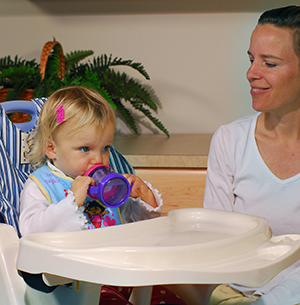When Your Child Has Diarrhea
Diarrhea is defined as loose poop that's more frequent and more watery than normal. It’s one of the most common illnesses in children. Diarrhea can lead to the body losing too much fluid (dehydration), which can be serious. So preventing dehydration is important in managing your child’s diarrhea.
What causes diarrhea?
Diarrhea may be caused by:
-
Bacterial, viral, or parasitic infections (such as Salmonella , rotavirus, or Giardia)
-
Food intolerances (such as dairy products)
-
Medicines (such as antibiotics)
-
Intestinal illness (such as Crohn’s disease)
What are common symptoms of diarrhea?
Common symptoms of diarrhea may include:
-
Looser, more watery poop than normal
-
More frequent poop than normal
-
More urgent need to pass poop than normal
-
Pain or spasms of the digestive tract
How is diarrhea diagnosed?
The healthcare provider examines your child. You’ll be asked about your child’s symptoms, health, and daily routine. The provider may also order lab tests. These may include tests of your child's poop (stool studies) or blood tests. These tests can help find problems that may be causing your child’s diarrhea.
How is diarrhea treated?
 |
| Have your child drink plenty of fluids to prevent dehydration from diarrhea. |
Your child's healthcare provider can talk with you about treatment options. These may include:
-
Preventing dehydration by giving your child plenty of fluids (such as water). Infants may also be given a children’s electrolyte solution. Limit fruit juice, soda, and sports drinks. These have a lot of sugar.
-
Giving your child prescribed medicine to treat the cause of the diarrhea. Don't give your child antidiarrheal medicines unless told to by the provider.
-
Eating starchy foods, such as cereal, crackers, or rice.
-
Removing certain foods from your child’s diet if they're causing the diarrhea. Your child may need to stay away from dairy products and foods high in fat or sugar until the diarrhea has passed. But most children can eat a regular diet, which will actually help them recover more quickly.
-
Infants can usually continue to breastfeed.
When to call your child's healthcare provider
Call the healthcare provider if your otherwise healthy child:
-
Has diarrhea that lasts longer than 3 days.
-
Has a fever (see "Fever and children" below)
-
Can't keep down any food or water.
-
Shows signs of dehydration (very dark or little urine, no tears when crying, dry mouth, or dizziness).
-
Has blood or pus in the poop or has black, tarry poop.
-
Looks or acts very sick.
-
Has belly pain that lasts or gets worse
Fever and children
Use a digital thermometer to check your child’s temperature. Don’t use a mercury thermometer. There are different kinds and uses of digital thermometers. They include:
-
Rectal. For children younger than 3 years old, a rectal temperature is the most accurate.
-
Forehead (temporal). This works for children age 3 months and older. If a child under 3 months old has signs of illness, this can be used for a first pass. The provider may want to confirm with a rectal temperature.
-
Ear (tympanic). Ear temperatures are accurate after 6 months of age, but not before.
-
Armpit (axillary). This is the least reliable but may be used for a first pass to check a child of any age with signs of illness. The provider may want to confirm with a rectal temperature.
-
Mouth (oral). Don’t use a thermometer in your child’s mouth until they are at least 4 years old.
Use the rectal thermometer with care. Follow the product maker’s directions for correct use. Insert it gently. Label it and make sure it’s not used in the mouth. It may pass on germs from the stool. If you don’t feel OK using a rectal thermometer, ask the healthcare provider what type to use instead. When you talk with any healthcare provider about your child’s fever, tell them which type you used.
Below are guidelines to know if your young child has a fever. Your child’s healthcare provider may give you different numbers for your child. Follow your provider’s specific instructions.
Fever readings for a baby under 3 months old:
-
First, ask your child’s healthcare provider how you should take the temperature.
-
Rectal or forehead: 100.4°F (38°C) or higher
-
Armpit: 99°F (37.2°C) or higher
Fever readings for a child age 3 months to 36 months (3 years):
-
Rectal, forehead, or ear: 102°F (38.9°C) or higher
-
Armpit: 101°F (38.3°C) or higher
Call the healthcare provider in these cases:
-
Repeated temperature of 104°F (40°C) or higher in a child of any age
-
Fever of 100.4°F (38°C) or higher in baby younger than 3 months
-
Fever that lasts more than 24 hours in a child under age 2
-
Fever that lasts for 3 days in a child age 2 or older